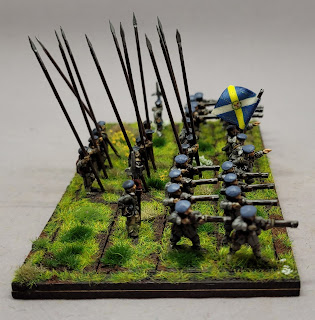Streeter, Streater, Sprigge or Sturt?
The famous engraving of the order of battle at Naseby is generally known as Streeter's map. In fact that is how I refer to it throughout this blog.
Eagle eyed amongst you will notice that there are two versions of the plan of Naseby, one with a portrait of the Fairfax top right, and one without. The Royal Collection, and the British Museum both have a copy with Fairfax on and attribute these to Streeter.
Robert Streeter, sometimes Streater, 1624-80 (or 1621-79 depending upon your source material) was a painter and etcher. Widely known and celebrated he was mentioned by Pepys in his diaries.
This is where Sprigge comes in: the plan is sometimes attributed to Joshua Sprigge as the illustration appeared in his book "Anglia rediviva: England's recovery: being the history of the motions, actions and successes of the army under the immediate conduct of His Excellency Sir Thomas Fairfax, Captain-General of all the Parliament's forces in England". Sprigge wrote the book (and incidentally was Sir Thomas Fairfax's chaplain), Streeter created the plan.
However, the V&A and the National Army Museum both have copies which do not have Fairfax illustrated; these they attribute to John Sturt (1658-1730). Sturt's plan appeared in John Rushworth's seven volume "Historical Collections of Private Passages of State".
So the big question is which is the original version?
Further investigation has provided an answer: the British Museum document that the Fairfax version by Streeter is the original, and the version without Fairfax was Sturt's copy of Streeter's original. Streeter's original was first printed in 1647, Sturt's from c1680.
I imagine that Sturt was playing to the restored monarchy, which would explain the removal of Black Tom.
Armed with this knowledge you can now stand in the Royal Armouries, Leeds, and indignantly point at the interpretation panel claiming to show Streeter's plan when in fact it shows Sturt's.
If you would like to see an original copy of the plan on display, then you will need to pop along to the National Army Museum, to see their Sturt.
Eagle eyed amongst you will notice that there are two versions of the plan of Naseby, one with a portrait of the Fairfax top right, and one without. The Royal Collection, and the British Museum both have a copy with Fairfax on and attribute these to Streeter.
Robert Streeter, sometimes Streater, 1624-80 (or 1621-79 depending upon your source material) was a painter and etcher. Widely known and celebrated he was mentioned by Pepys in his diaries.
This is where Sprigge comes in: the plan is sometimes attributed to Joshua Sprigge as the illustration appeared in his book "Anglia rediviva: England's recovery: being the history of the motions, actions and successes of the army under the immediate conduct of His Excellency Sir Thomas Fairfax, Captain-General of all the Parliament's forces in England". Sprigge wrote the book (and incidentally was Sir Thomas Fairfax's chaplain), Streeter created the plan.
However, the V&A and the National Army Museum both have copies which do not have Fairfax illustrated; these they attribute to John Sturt (1658-1730). Sturt's plan appeared in John Rushworth's seven volume "Historical Collections of Private Passages of State".
So the big question is which is the original version?
Further investigation has provided an answer: the British Museum document that the Fairfax version by Streeter is the original, and the version without Fairfax was Sturt's copy of Streeter's original. Streeter's original was first printed in 1647, Sturt's from c1680.
I imagine that Sturt was playing to the restored monarchy, which would explain the removal of Black Tom.
Armed with this knowledge you can now stand in the Royal Armouries, Leeds, and indignantly point at the interpretation panel claiming to show Streeter's plan when in fact it shows Sturt's.
If you would like to see an original copy of the plan on display, then you will need to pop along to the National Army Museum, to see their Sturt.
For those of you unable to visit a museum to inspect a copy, here's the Royal Collection zoomable online copy. (To be honest, unless you manage to get yourself a copy of the plan, this is the best way to see the plan.)
The Cromwell Museum created an animated version of Streeter's Plan showing the course of the battle. You can find it here.
Footnote:
I tracked down an original Sturt print, dating from c1680. Here it is:
For those of you not so lucky at finding an original Streeter or Sturt: prints and postcards of both the Streeter and Sturt versions of the plan can be purchased from Magnolia Box (the Streeter version is much easier to find in their system though). A print on demand business they also have listed in their catalogue a number of portraits and wood prints of generals and notable figures.
Footnote:
I tracked down an original Sturt print, dating from c1680. Here it is:
For those of you not so lucky at finding an original Streeter or Sturt: prints and postcards of both the Streeter and Sturt versions of the plan can be purchased from Magnolia Box (the Streeter version is much easier to find in their system though). A print on demand business they also have listed in their catalogue a number of portraits and wood prints of generals and notable figures.
If you enjoyed reading this, or any of the other posts, please consider supporting the blog.
Thanks.














Comments
Post a Comment